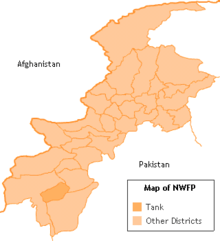Miani (Pashtun tribe)
Miani, or Mayani,[1] (Pashto: Mianrhi) is a Pushtuns that mainly inhabit the Gomal plains of Pakistan in the Tank District of Khyber Pakhtunkhwa, which was formerly North-West Frontier Province.[2] They arrived in the Gomal plains by 1850. There are also Miani people within the Dera Ismail Khan District of Pakistan.
History
| Total population | |
|---|---|
| (several millions) | |
| Regions with significant populations | |
| Afghanistan, Pakistan | |
| Languages | |
| Pashto, Urdu, Dari | |
| Religion | |
| Islam | |
| Related ethnic groups | |
| other Pashtun tribes, other Iranian peoples |
The Miani are believed to be a Shirani tribe, that descended from the Sarbanis in India,[3][4] and then were of Afghanistan.[3]
A number of clans and sub clans of Miani tribe were Powindahs, who migrated between Afghanistan and Pakistan, afterwards large number of them settled in the Gomal Plains along with their other earlier settled tribesmen.
Gomal plains

Though initially a nomadic tribe, Mianis settled in the Gomal plains[5] by or before 1850. According to the book, Imperial Frontier: Tribe and State in Waziristan by Hugh Beattie, the estimated population of nomadic Miani tribe was about 800 in the 1870s. They were a semi-independent group that lived along the Tank border, except for the hot season, when they moved into the hills. They were living among a small tribe, the Ghorezais (or Ghwarazai), of whom there were about 350 people. The larger tribe in the area was the Wazir, of whom there were a couple thousand people.[6]
An important technique that the British used to manage the frontier was to make certain tribes responsible for monitoring who had passes to travel on particular routes into the hills. They called this “pass responsibility”.[7] The Bhitannis first accepted pass responsibility on the Tank frontier.[8] Then, pass responsibility for the Girni, Murtuza and Manjhi posts was assigned to the Miani and Ghurezai tribes in 1876.[9] That year, they also accepted responsibility for monitoring passage into the Gomal Valley, as did a portion of the Ghwarazai that lived away from the other clan members of the Kakar tribe of Baluchistan.[8]
In January 1879, Tank was raid by the Mahsud,[10] and the Miani and Ghwarazai became in the resulting disorder. However, they were "soon reduced to Hiihniission."[8]
Dera Ismail Khan District
The Miani of the Gomal plains are also allied with, and reside during the winters with, the Miani of the Dera Ismail Khan District who are a Pathan (Pashtun) tribe, according to Horace Arthur Rose. There were about 400 people, based on the book that used census data from 1883 and 1892.[11]
References
- ↑ Constable's Hand Atlas of India. A. Constable and Company. 1893. p. 51.
- ↑ "Dissertation - "The Laws and Justice System in FATA and Recommendations for their Reformations"". Scribd. Retrieved 2016-11-29.
- 1 2 Commissioner, India. Census (1902). Census of India, 1901: India I. Report. Office of the Superintendent of Government Printing, India. p. 88, 90, 106.
- ↑ Ni'mat-Allah; Dorn, Bernhard (1836). History Of The Afghans: Translated From The Persian Of Neamet Ullah By Bernhard Dorn. Valpy. p. 41.
- ↑ Balfour, Edward (1885). The Cyclopaedia of India and of Eastern and Southern Asia. II. Graz, Austria: Akademische Druck-u. Verlagsanstalt. p. 222.
- ↑ Beattie, Hugh (December 16, 2013). Imperial Frontier: Tribe and State in Waziristan. Routledge. p. 13. ISBN 978-1-136-83957-3.
- ↑ Beattie, Hugh (December 16, 2013). Imperial Frontier: Tribe and State in Waziristan. Routledge. p. 34. ISBN 978-1-136-83957-3.
- 1 2 3 Howell, Evelyn Berkeley (1979). A Monograph on Government's Relations with the Mahsud Tribe. Oxford University Press. p. 119.
- ↑ Hugh, Beattie (2013). Imperial Frontier: Tribe and State in Waziristan. 2 Park Square, Milton Park, Abingdon,Oxon, OX14 4RN 711 Third Avenue New York, NY10017: Routledge. p. 115. ISBN 0-7007-1309-3.
- ↑ Beattie, Hugh (December 16, 2013). Imperial Frontier: Tribe and State in Waziristan. Routledge. p. 137. ISBN 978-1-136-83957-3.
- ↑ Rose, Horace Arthur (1997). A Glossary of the Tribes and Castes of the Punjab and North-West. 3. New Delhi: Nirmal Publishers & Distributors. pp. 101, title page. ISBN 81-85297-70-3.
Further reading
- Paget, William Henry (1874). A Record of the Expeditions Undertaken Against the North-west Frontier Tribes: Compiled from the Military and Political Despatches, Lieut.-Colonel McGregor's Gazetteer, and Other Official Sources. Office of Superintendent of Government Printing. pp. 135, 142–144.